The latest in a series of interviews with artists who have a significant body of work that makes use of or responds to network culture and digital technologies.
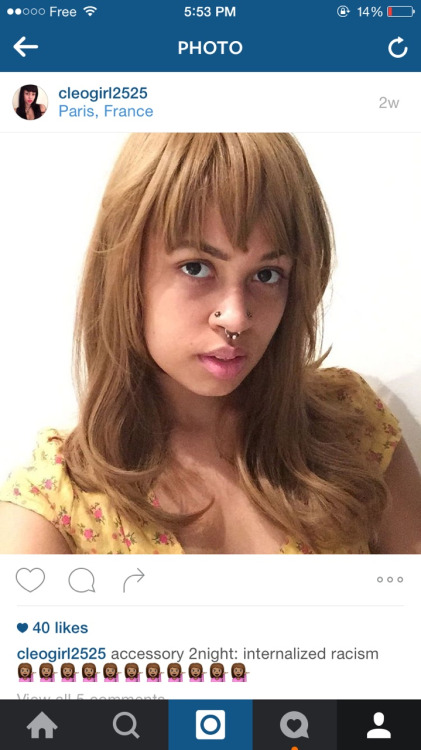
Shawné Michaelain Holloway, snow white LQQKS by black bitch_latergram (2015)
GC: Self-representation is a recurring theme of internet-based art, one that you approach from a specific perspective: as a queer, black, [self-described] privileged individual. In your Cam-Era work, you perform this identity within the Camgirl business. How did the power dynamics of this environment affect the work you were making at the time?
SMH: Power dynamics affected this work not because of the power of the people or the culture inside, but the power of the people and the culture outside looking in. I feel ashamed that I see these spaces as a playground where I get to construct my own fantasies and control my environment. In a lot of ways I am excited about this non-corporal freedom I gain there—like sexually excited. We all want something intangible that we can't have and there's always these fucked up political connotations that are attached to these desires. I use these people online just as much as they're using me and I’m secretly really happily ashamed of that. I use people online because I can't bring myself to do it IRL. See the connections? I think my way of somehow ritualistically absolving myself of this shame is by producing these videos. The product for me is a kind of stain, and I think the footage reflects it—it is all really dark and self-aware in this way. My piece, nothing_fucking_matters_II: cuter on the internet.mp4 (2014), is an animated second-self portrait that’s on the surface very tongue in cheek and feels familiar, aesthetically, but these clips of me are all selections of moments that gross me out a bit when I watch them. I can see a kind of blind enjoyment there that I generally don’t get offline in sexual situations, and that makes me both angry and giddy.
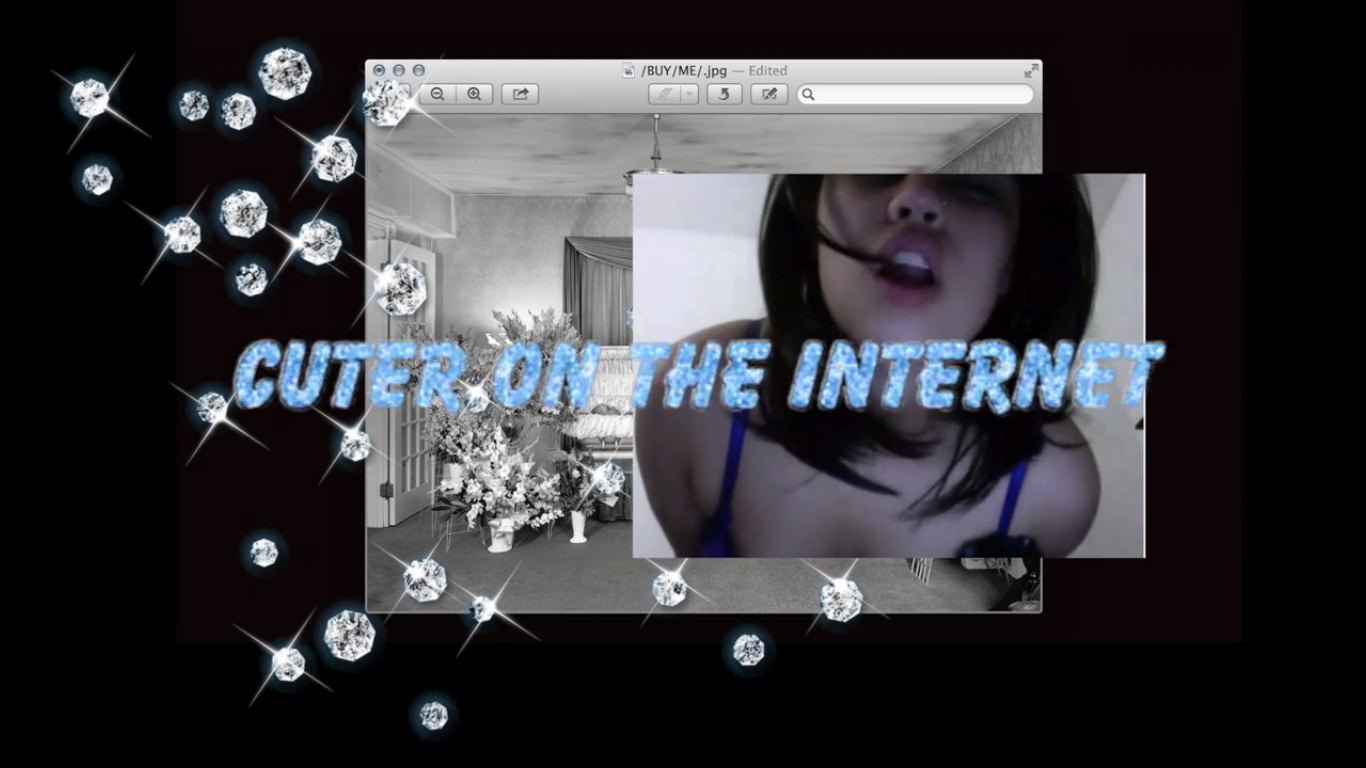
Shawné Michaelain Holloway, nothing_fucking_matters_II cuter on the internet_mp4 (2014)
My fantasy-fetish for control and power over my representation is constantly being fulfilled by my occupation (or is it a hobby? I don't know.) When I feel like my game is strong and people are responding in the way I’ve organized them to, it’s simultaneously the most unhinged and highest feeling I am able to experience. There's also another layer though, playing this black femme domme goddess online is affirming my fears about being not enough of a black femme domme goddess in real life—and this is a real problem for me because I shouldn't have to feel like that. My feelings about being mixed race and being raised not to see color are complicated.
Literally though, it tickles me to see the control aspect extending to everything. This is where my educated New Media MFA eye begins and my masochistic, animal self that's instinctively navigating this community stops. The control thing is even exaggerated by the very UX of the job; built into all the sights are the little wysiwyg style customization capabilities of the "about me" pages, the culture of competition for finding the most creative activities you can run with your audiences, the Amazon wishlist culture, and the endless options you can choose from when deciding what type of cam site you want to work for.
GC: Camming seems like a very straightforward system to monetize the ever-present male gaze. While being part of a market for the visualization of bodies, you stayed in control of your image by drawing boundaries when it came to nudity, and by having a critical perspective. What was your process like when translating your experiences into your video and jpeg work?
SMH: It's true, camming is a super straightforward way of monetizing the male gaze; but personally, thinking about it in this way implies a kind of revenge, and that's not what I want to communicate. Depending on how you want look at it, I'm simply monetizing my labor (both physical or emotional) and I believe this is an even more feminist motivation. Somehow I feel I'm entitled to compensation for this, so I simply go out and I take it. 100% of the footage in my early artwork has been paid for, and I think there's an interesting connection there, too. Does that say something about feeling entitled to being compensated for the time I spend making art too? Maybe.
Again, everyone talks about what's expected of the girls inside the community and how fucked the things are that they/we do for money. I get that, but for me, it is less about those questionable interactions (that do happen—I’m not denying that) when I am #LIVE than what happens immediately afterwards: when I am quiet, sitting on the couch in this intentionally location-less mess of a workspace (depressing), in my corsets or wigs or whatever (complete fakery, all for the very real purpose of feeling like an idealized self). The voices begin to creep in and tell me that what I am doing isn't ok and that I should be ashamed, either because: I'm a slut if I like what I'm doing, that I'm over-educated to be doing this kind of work (because it is work—hard work), that my family wouldn't love me anymore if they found out, etc. THIS is really effect of the slut-shame-y power dynamics of the external world that I feel most complicated about.
a_personal_project, IV: password protected thaumatrope, security measures for a caged bird.mov (2014) discusses this in detail. This is literally just a letter to myself—if I begin to become reliant on the performance of this identity—to come down and realize that I don't really need it. Exploration and experimentation is ok but when it becomes a requirement to retain my self-confidence rather than a product of my self-confidence, well—then, I really need to realize that. In that nightmare, there is something really very wrong —that I've managed to become the caged bird and all my control is lost.
Since making this work, I’ve stopped camming and I haven’t created that same kind of work again. There’s a noticeable decrease in overt sexuality with my more recent work, which has been mostly explorations of racial identities and real time sound performance [Cassion].
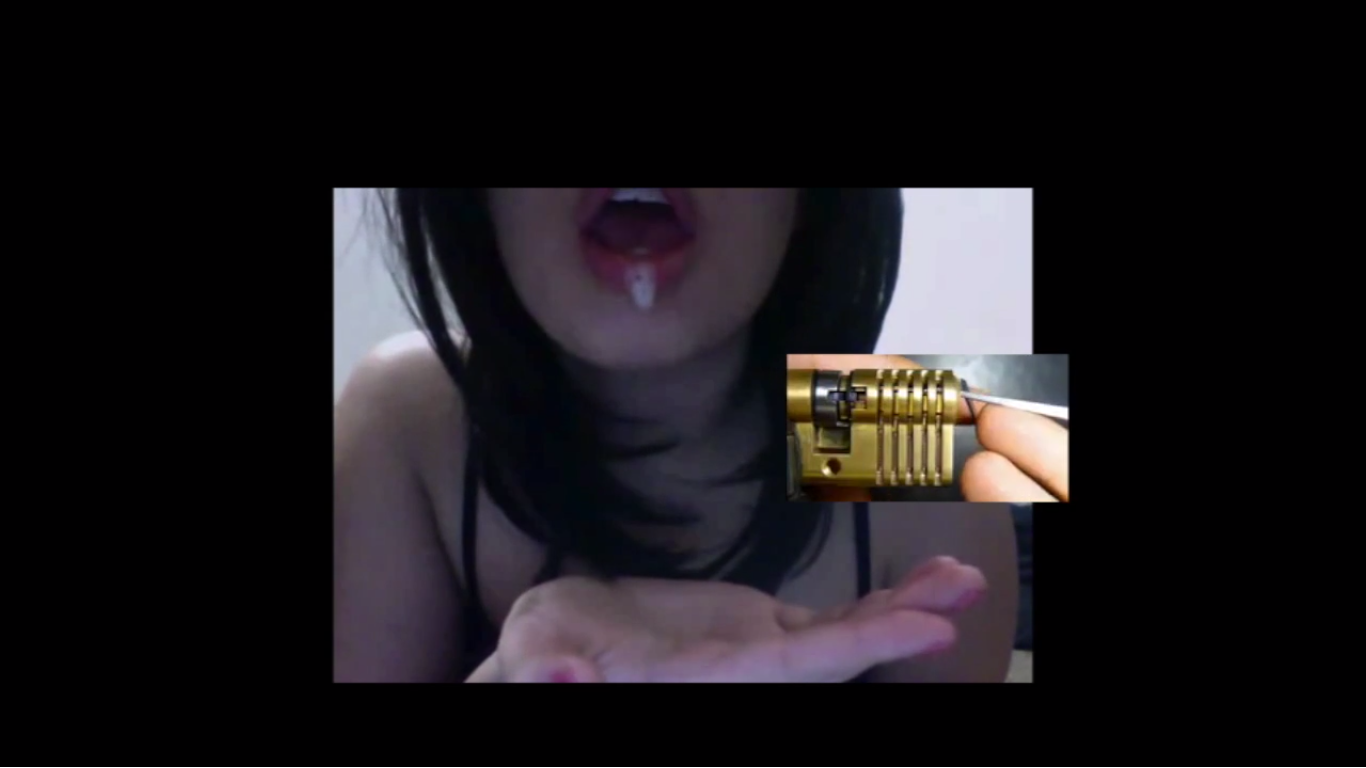
Shawné Michaelain Holloway, a_personal_project, IV password protected thaumatrope, security measures for a caged bird_mov (2014)
GC: In your series Picking Skin you deal with the readjustment of your racial identity when you relocated from Chicago to Paris, and your sudden willingness to insert yourself into a specific Black Canon/Legacy. Can you talk more about this work and the experiences that led to it?
SMH: The work of Lorraine O'Grady really helped me find my identity in Paris. Suddenly, I had to think about defining myself within a space where I not only felt invisible but, since I didn't speak a word of French, it was like I'd lost my ability to adopt a new culture or connect with hidden ones. In Chicago, I think I was hiding out in a subculture of artists where I could be queer, American, mixed race, boi, whatever—it didn't matter. At home, I didn't have to interact with people who didn't accept that. In Paris, I became forced to zoom out and interact with a public. I was totally fresh off the boat and I found quickly that my American-ness was the last thing helping me navigate, but my blackness did. I began looking for myself in others and all of a sudden I realized I belonged in this society in a different way than I did at home. I wasn't the only black person in the room or on the train; I wasn't even the only mixed person.
I was well into this process when I first saw Miscegenated Family Album by Lorraine O'Grady. I identified (and still do!) so profoundly with the one-to-one comparisons it offers. The fact that it is called a "Family Album" also seems really fitting. My images, created in her established methodology, exist as an extension or an addition to a real extended family with a #real #extended legacy: the legacy of womyn, of black womyn; while trying to uncover potential for any hidden connections in the process.
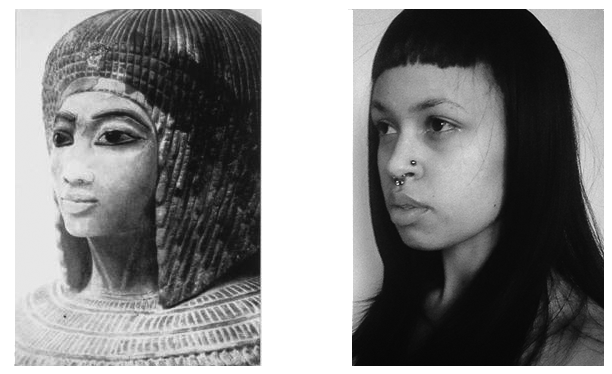
Shawné Michaelain Holloway, Miscegenated-Family-Album_Sisters-II (2015)
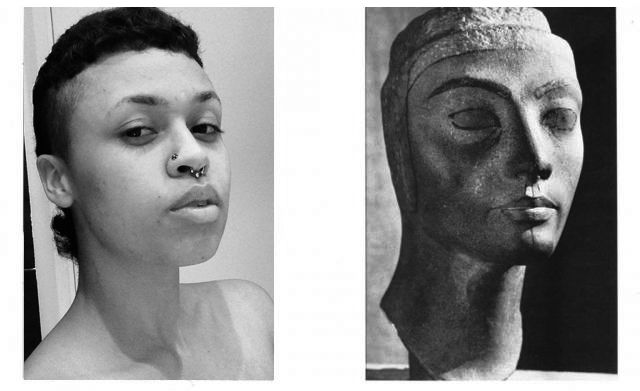
Shawné Michaelain Holloway, Miscegenated-Family-Album_Progress-of-Queens (2015)
Each piece is a diptych, and in an interview O'Grady describes the diptych as being a "typical form for bicultural people." This is one obvious way of representing relationships that helped me zoom in to small details like eyes or shoulders, facial expressions and small gestures. Unlike O'Grady though, sometimes my work pushes the definition of family. 2SYSTRS.PHOTOlib is a series in which I make a direct comparison between parts of the porn star Skin Diamond and parts of myself. Here, I try to play the power dynamics out a bit: for me, comparing the self to idolized sculptures is great, so I picked the kind of "sculptures" that I idolize—porn stars. I’m always looking for union and familiarity in the seemingly unattainable—sisterhood especially. Following the exploration with O'Grady, I became adamant about starting a conversation with these women whose work I study so closely. Carrie Mae Weems is another one I align myself with. I make remakes of Mirror Mirror at least once a week. This one and this one were the first two, and they have evolved over time into abstractions like this.
GC: It's interesting how it's a sort of digital trespassing—a very loving one—in which you use the lo-fi/widely available tools of digital production to introduce yourself in this upper echelon of black female artists. It's also very different from your previous work, but still very identity-based. How do you see these new works fitting within the whole of your practice?
SMH: This new series is not so different to me. I made the cam girl stuff when I was just figuring out what art meant to me and how I could use the tools I already had to make it. Everything I've ever created is about having or understanding a shared experience and/or having my interpretation of an experience contribute to some subcategory of collective memory. I told Kimberly Drew that "everything that I've made is one singular artwork," and I maintain that.
In my earlier work, I was talking about a feminist memory, and now I’m talking about a black memory. My aesthetic and medium choices are fluid so that doesn’t even factor into it for me; if I never made another video or image again it would be fine as long as I’m creating and responding to what’s out there. "There," for me, happens to be web right now, but tomorrow it could be IRL in the middle of a field. Regardless of the content of my work, my intention is to say "there’s more than one way to be. Here: let me add to this context because I don't see what I want to see already represented."
Most of all, I really wish I could talk to these women I've mentioned. Instead of reaching out, I staged an interview with Carrie Mae Weems based on a video I saw. Every question she asked, I answered in effort to self-evaluate and to align myself with that particular arts tradition. I also put myself next to her in works like this.
As I move forward with Picking Skin, however, I do realize I need to reach out and interact more. My super dream project is to realize one of the O'Grady reworks in a video in creative collaboration with Shine Louise Houston and in performative collaboration with Skin Diamond. I'm tired of waiting around for someone to realize that I'm black and I'm making art and I've got something to say. I'm #OutHere, you know.
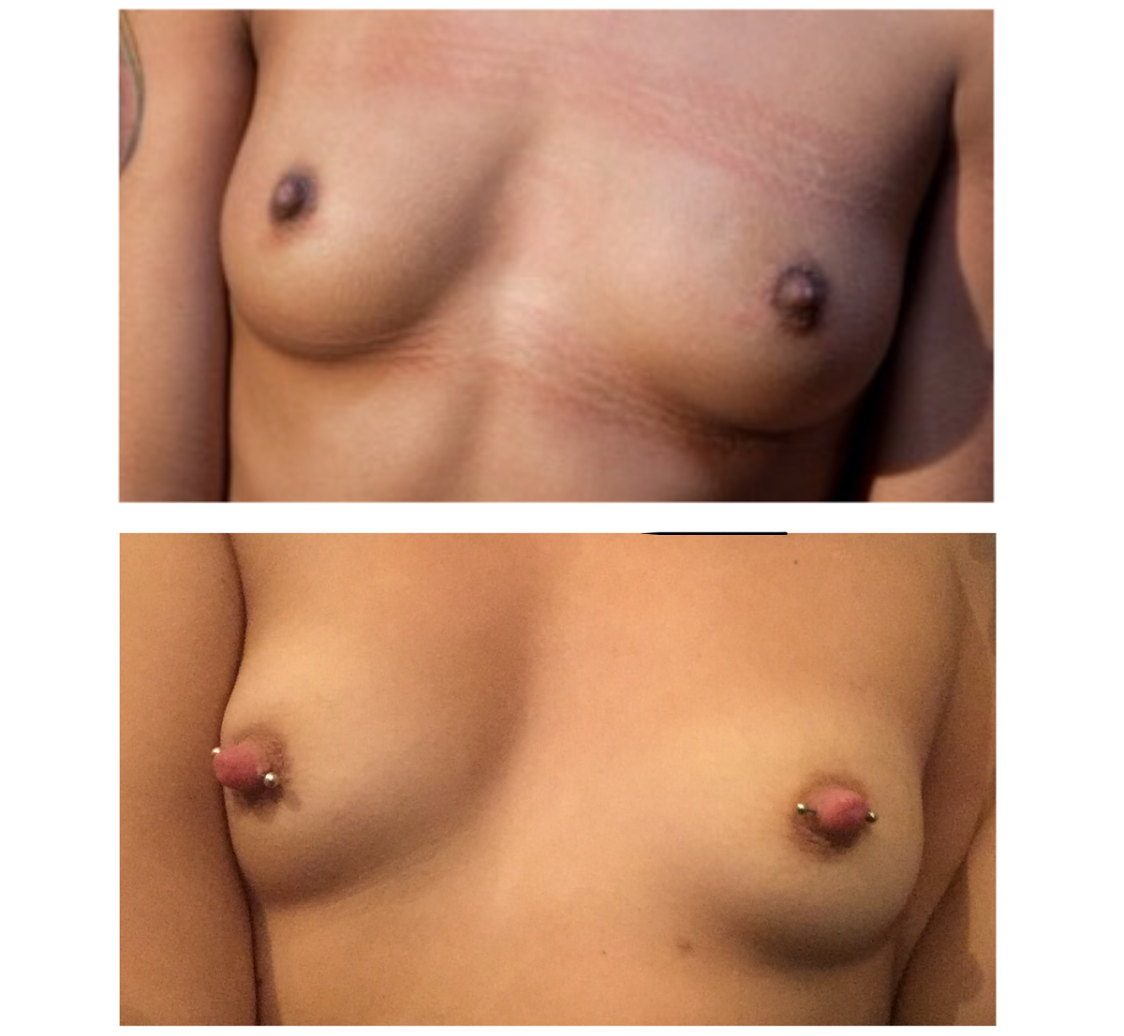
Shawné Michaelain Holloway, 2SYSTRS.PHOTOlib (2015)
Questionnaire:
Age: 24
Location: Chicago, IL in heart / Paris, France with my body
Where did you go to school? What did you study?
I went to Shimer College where I studied under the great books curriculum with a focus on Political Science. Then, I got my BFA from the School of the Art Institute of Chicago where I focused on Film, Video, New Media, and Animation. Now, I'm working on a Master's degree with The New School's Design and Technology program at Parsons Paris.
How/when did you begin working creatively with technology?
In my second year at SAIC, I knew nothing about media or technology and accidentally rolled up into a class with jonCates and Daniel Eisenberg. I thought it would be easy but it blew my brain apart and I became convinced that I needed to add to this history, so I began the next semester taking 18 credit hours full of cinema studies and glitch art themed classes.
What do you do for a living or what occupations have you held previously?
Most notably, I was a sex educator. I taught sex technique classes and entertained ladies with blowjob secrets and flirty dating tips at bachelorette parties. Now, I'm taking a few months off to travel and focus on academics.
What does your desktop or workspace look like? (Pics or screenshots please!)
